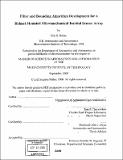Filter and bounding algorithm development for a helmet mounted micromechanical inertial sensor array
Author(s)
Bailey, Erik S. (Erik Stephen), 1975-
DownloadFull printable version (14.38Mb)
Other Contributors
Massachusetts Institute of Technology. Dept. of Aeronautics and Astronautics.
Advisor
Tom P. Thorvaldsen.
Terms of use
Metadata
Show full item recordAbstract
The technical evolution of head mounted displays (HMDs) and micromechanical inertial sensor arrays (MMISAs) have, until recently, occurred independently. This thesis details the development and simulation results of an inertial helmet-mounted head tracker for a T- 38 jet aircraft flight environment. Primary focuses are the state error estimation filter and the bounding algorithms used to estimate the head position and orientation during various flight conditions. Also included is a discussion of the application of the Draper MMISA to a cueing system for an HMD in a military air vehicle environment. Particular attention is paid to necessary requirements to meet pointing accuracies for fire control system handoff applications for the next generation of air to air missiles, such as the AIM-9X Sidewinder missile. A Markov process coupling technique used in this research is shown to achieve pointing accuracies of 4 to 11 milliradians. A generalization of the navigation filter to any number of inertial navigators with known relative positioning and attitude coupled using Markov process propagation matrices is also included, along with examples of future applications, in addition to helmet-mounted cueing systems, for vehicle applications.
Description
Thesis (S.M.)--Massachusetts Institute of Technology, Dept. of Aeronautics and Astronautics, 2000. Includes bibliographical references (p. [125]-[126]).
Date issued
2000Department
Massachusetts Institute of Technology. Department of Aeronautics and AstronauticsPublisher
Massachusetts Institute of Technology
Keywords
Aeronautics and Astronautics.